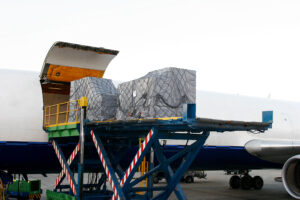Mar 11, 2024

From the Panama Canal drought, to predicted Chinese New Year logjams, to the Red Sea crisis, there’s no wonder some global companies switched to air transport in January. Will the disruption to established global airfreight patterns continue, and will rapid intermodal switches become the new normal? David Jinks MILT, Head of Consumer Research at the international delivery expert ParcelHero, looks to the skies.
The last few years have seen global supply chains at snapping point. During the Covid pandemic, it was companies who relied on airfreight who caught a cold. The collapse of international passenger flights had repercussions for cargo too as a considerable amount of airfreight is transported in the belly hold of passenger aircraft. Much publicised, but rather half-hearted, attempts to strip out passenger seats to get more airfreight services flying, failed to convince.
Wind forward from 2020 to 2024 and the situation has been reversed. A severe and ongoing drought in Panama has seen its canal face increasingly severe restrictions for months, while attacks on ships heading for the vital Suez Canal shortcut continue in the Gulf of Aden and the Red Sea. The result is that global airfreight is taking off once more, albeit on specific routes and particularly for more time sensitive cargos.
Add the impact of the annual two-week-long Chinese New Year festivities, which saw ports close and vessels and containers stationary and there were always going to be repercussions.
READ: International trade takes to the skies to navigate Chinese New Year and Red Sea disruption
The most significant result was a 10% increase in airfreight in January, with global air cargo tonnages rising 24% in one week. As a result, air cargo spot rates from China to the US rose 14% in the first week of February. At the same time, China to Europe airfreight saw an 8% spot rate increase, with prices averaging 20% higher than mid-January.
You might think that most traditional maritime users, used to highly competitive shipping rates, would baulk at the costs involved in switching to air cargo services. But the Houthis’ attacks on global shipping are forcing many shipping companies to divert from the Red Sea-Suez Canal route to the Cape of Good Hope, adding around nine days on a typical voyage between China and Europe. That means delays and increased fuel and insurance costs. With this in mind, airfreight has been looking increasingly competitive.
With maritime service already disrupted, the Chinese Lunar New Year celebrations sparked a scramble for aviation services, as businesses rushed to get products out before the festivities began. Fast-fashion lived up to its name by quickly deciding to divert products, with air cargo volumes from Vietnam (a major fashion producer) spiking 62% in one week in January, up 16% on the same week in 2023.
Now that the impact of the Chinese Lunar New Year is, thankfully, disappearing in the rearview mirror, we’ll see if demand for airfreight falls off accordingly, or if increased localised air cargo demand holds firm.
Alibaba’s freight market update for the week ending 23 February revealed airfreight rates to Europe again saw a marginal increase. It attributed this to a slight uptick in demand as shippers look for alternatives to ocean freight amidst ongoing disruptions. The TAC Index report, also from 23 February, indicated airfreight rates from India are still increasing. That’s again likely to be because some shipping companies are using air transport to cope with sea transport issues.
READ: Israel crisis: the impact on exports and deliveries
On the other hand, after climbing rapidly just before Chinese New Year, airfreight rates from Hong Kong decreased by 13% in the week ending 23 February, while rates from Shanghai decreased by 11.5%. So, the jury is still out on how long and how firm any air cargo rates increases will be.
One thing for sure is that anyone banking on tumbling Asia-Europe air cargo rates in 2024 as a result of a sluggish global economy may have to think again.
Perhaps the main result of the chaotic beginning to 2024 will be that global companies, having found out how relatively easy it is to switch some cargo from sea to air, will be more willing to do so again in the future.
Regular airfreight users will have to keep a closer eye on maritime disruptions, be they attacks on shipping, natural disasters or strikes by port workers, to ensure their normal rates and schedules aren’t disrupted. It’s going to take a while for sea and airfreight services to settle down to the new normal.
The post Modal switch: will the jump from ocean to air continue as traditional global supply chains snap? appeared first on AIR CARGO WEEK.
Go to Source
Author: David Jinks MILT




